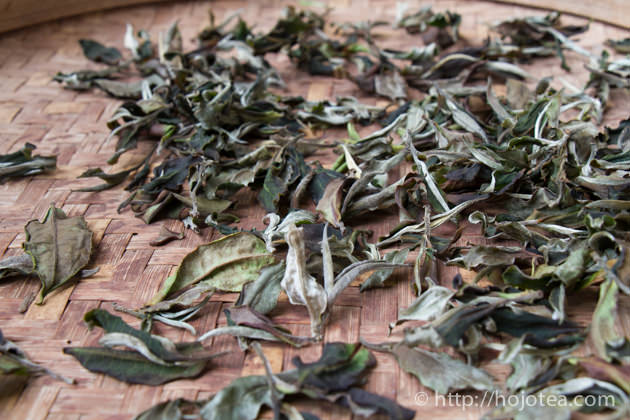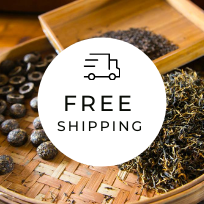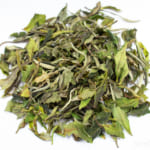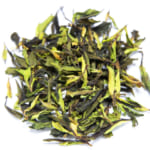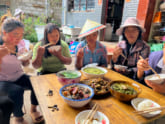- HOME >
- Types of Tea
Development of lightly rolled Japanese green tea
- [2016.02.11] Posted By Akira Hojo
Japanese green tea is less lasting in brewing
Many people may find that the taste and flavor of Japanese green tea do not last over many infusions. The first infusion is strong and flavorful, but on third or even the second infusion, most of Japanese green tea tastes light and plain. Regardless of the brewing style, it is mainly because of the tea leaf is rolled very tightly. Because of this, when tea is brewed the taste and flavor comes out very quickly. Many of us are accepting it since we think it is the nature of Japanese green tea. However, I started wondering why it is rolled so tightly. If Japanese tea is rolled lightly, it should be able to last many more infusions.
The appearance of tealeaf influences the process
In Japan, the shape of tea leaf is considered as one of the very important quality criteria. The tea leaf with needle shape is being highly appreciated. Some people appreciate hand-rolled Japanese green tea and willing to pay a high amount for it. Usually the slimmer the tea leaf, the higher the pressure is given. As a result, more cells have been macerated, and more substances are extracted during tea brewing. However, the rolling is not really affecting the base characteristic of green tea. The characteristic of green tea is set based on the steaming time and the extent of heat treatment in the subsequent process. Thus, the tighter rolling is purely meant for the elution of tea constituents.
White tea is produced without rolling
In fact, some teas are produced without rolling, for example, the white tea. The process of white tea is as follow:
Withering >> Heating to stop fermentation >> Drying >> Moderate baking. Despite the white tea is not rolled, we still enjoy the flavor and taste of white tea just like other teas. Thanks to no rolling process, the freshness of white tea lasts over many brewing. Generally, as compared to other tea categories, the rolling for raw pu-erh tea is very gentle. We sometimes come across the pu-erh tea that is rolled very tightly. No doubt that the flavor of these teas lasts shorter than those that are rolled softly.
The rolling is important for black tea
In making black tea, the rolling process is very important. When tea leaves are macerated in rolling action, the enzyme and substrate in tealeaf mixes together and initiate enzymatic fermentation. In making black tea, rolling is one of the critical processes which affect the consistency of fermentation. But the process of making green tea involves no fermentation. Then why is it so important to roll green tea so tightly?
The requirement of Umami may caused the Japanese green tea is tightly rolled
Why Japanese green tea is rolled tightly? One of the reasons could be due to the umami, which has been often regarded as a quality index of Japanese green tea. Umami is the amino acid compound called theanine. https://hojotea.com/en/posts-47/
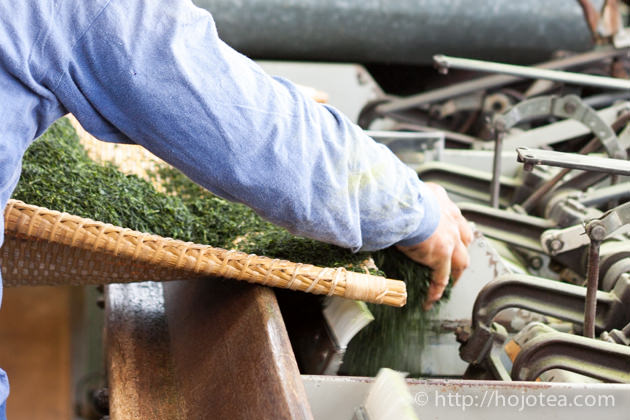
Umami in tea was discovered by Dr. Sakado in 1950s. Since then people started to associate umami with the quality of green tea. This idea has been greatly supported since it matched the modern agricultural practice. This idea back-up the modern agricultural practice since the more umami is composed if more fertilizer is used. The idea of umami as a quality index made everyone very happy. It created the demand of fertilizer, and based on the umami index, the quality of tea grown with fertilizer was justified. At the same time, rolling became very important. With tighter rolling, the more umami substance will be eluted during tea brewing.
However, the more umami means more fertilizer. In tea, the extent of umami and the level of aftertaste is at inverse proportion, i.e., more umami tea normally has less aftertaste. In order to accumulate more mineral content, tea tree has to grow slowly under the severe environment. In Chinese, Taiwanese and Indian tea, the aftertaste is rather a more important tea quality index.
Developing very lightly rolled Japanese green tea
Generally, I am always looking for the tea grown in natural farming style. Natural farming means no nitrogen fertilizer is used, not even the organic nitrogen fertilizer. As compared to the tea grown in modern agriculture, the natural farming tea contains less theanine but a lot of poly phenol and minerals. Since the natural farming tea contains less amino acid, there is no reason we have to roll it tight. The main characteristic of natural farming tea is strong aftertaste and floral scent. To enhance this characteristics and makes tea lasting over many brewing, light rolling is definitely a good idea. With light rolling, the energy applied during process is lower. In addition, the surface of tea leaf is less than those that are rolled tighter and macerated more. Thanks to these facts, tea undergoes less oxidation during the process. As a result, not only we can brew tea many times, and also the tea becomes floral and very refreshing. Based on these ideas, I am planning to develop new style of Japanese green tea this year. I plan to use very light rolling and enhance the floral flavor. Since last year tea season, I have already started this project. We have conducted several trial runs in Tsukigase. If everything goes well, I should be able to introduce it this year.
Related Articles
How to get the latest update on HOJO Tea?
1. Follow Twitter, 2. Click "Like" on Facebook, and 3. Subscribe in newsletter. You can have the latest tea news from HOJO Tea.
 Subscribe the Newsletter to enjoy the privileges
Subscribe the Newsletter to enjoy the privileges- You may receive a free sample upon purchase, or you may have the priority to purchase special products. So please remember to subscribe our newsletter as well as the social network.
- Yunnan Chun Jian Green Tea from High Mountain Gardens
- Yunnan Chun Jian Green Tea is now available.This tea is made from naturally grown leaves harvested from high mountain gardens at 2100m above sea level. It has a rich, long-lasting lingering aftertaste, comparable to raw Pu-erh tea. Yunnan as a Distinctive Tea Growing Region Over the past 20 years, we have explored a wide range …
- Limited Loose Leaf Release of 2025 Da Xue Shan Wild Raw Pu-erh Tea
- We have released the 2025 loose-leaf version of Da Xue Shan Wild Raw Pu-erh Tea.This tea comes from wild tea trees that grow naturally in the high mountains of Yunnan Province, at elevations above 2000 meters. This year, we were only able to secure a small quantity for retail, and the current release is available …
NEW ARTICLES
 Yunnan Chun Jian Green Tea from High Mountain Gardens
Yunnan Chun Jian Green Tea from High Mountain Gardens- Yunnan Chun Jian Green Tea is now available.This tea is made from naturally grown leaves harvested from high mountain gardens at 2100m above sea level. It has a rich, long-lasting lingering aftertaste, comparable to raw Pu-erh tea. Yunnan as a Distinctive Tea Growing Region Over the past 20 years, we have explored a wide range …
 Limited Loose Leaf Release of 2025 Da Xue Shan Wild Raw Pu-erh Tea
Limited Loose Leaf Release of 2025 Da Xue Shan Wild Raw Pu-erh Tea- We have released the 2025 loose-leaf version of Da Xue Shan Wild Raw Pu-erh Tea.This tea comes from wild tea trees that grow naturally in the high mountains of Yunnan Province, at elevations above 2000 meters. This year, we were only able to secure a small quantity for retail, and the current release is available …
 2025 Da Xue Shan Wild White Tea Now Available from Yunnan
2025 Da Xue Shan Wild White Tea Now Available from Yunnan- The 2025 harvest of Da Xue Shan Wild White Tea is now available. Crafted from truly wild Camellia taliensis trees growing naturally in the high-altitude forests of Yunnan, this tea offers a purity and character unique to its origin. This year’s unusually dry climate during the withering season was ideal, resulting in a floral and …
 Why Do Some Teas Taste Astringent? Exploring the Causes and Mechanisms of Astringency
Why Do Some Teas Taste Astringent? Exploring the Causes and Mechanisms of Astringency- Tea can range from having no noticeable astringency to possessing a very strong one. What causes this astringency? This article explores the causes and mechanisms behind astringency in tea. Causes of Astringency Astringency arises from the binding of tea components to proteins in the oral cavity, creating a sensation of tightness or dryness. The tongue …
 The Impact of Heat Sources on Tea Flavor
The Impact of Heat Sources on Tea Flavor- It is widely recognized that the material of a kettle plays an important role in shaping the taste of water for brewing tea. Yet, an often overlooked but equally significant factor is the type of heat source used to boil the water. Different heat sources, whether gas, electric, charcoal, or wood fire, can impart distinct …
 New Release of High Mountain White Tea
New Release of High Mountain White Tea- We are pleased to introduce our High Mountain White Tea, sourced from a unique tea garden with two key features: 1. Located at an altitude of 2200-2300m2. Completely wild and untended The ideal natural conditions of this garden result in tea of exceptional quality, offering a pure and gentle, nourishing taste. High Altitude and Wild …
 New Release of Da Xue Shan Wild White Tea 2024
New Release of Da Xue Shan Wild White Tea 2024- We have released the 2024 Da Xue Shan Wild White Tea Loose Leaf. This tea was produced under our direct supervision during our stay in Yunnan Province, ensuring meticulous production management on site. Definition of Wild Tea in Yunnan Province People in Yunnan strongly associate Camellia taliensis with wild tea, regardless of where it is …
 New Release of Wild Pu-erh Jasmine Pearl
New Release of Wild Pu-erh Jasmine Pearl- Out of curiosity, we decided to create a jasmine tea based on Da Xue Shan Wild Raw Tea. This resulted in an exceptionally rare tea, not only in Japan but also in China. Custom Production Network for Jasmine Tea At our store, we source various types of base teas from different regions during the spring. …
 2024 Overview: Our Yunnan White Tea Quality, Process, and Weather Insights
2024 Overview: Our Yunnan White Tea Quality, Process, and Weather Insights- One of the teas we’ve been focusing on in Yunnan Province is white tea. Historically white tea has been produced in both Fujian Province and Yunnan Province for a long time. While white tea from Fujian Province is well-managed during processing, we are dissatisfied with the quality of the raw materials due to the use …
 Yunnan’s Hospitality Culture: Expressed Through Meals
Yunnan’s Hospitality Culture: Expressed Through Meals- In China, as a form of greeting, it’s common to say “你吃饭了吗?” which means “Have you eaten?” However, in Yunnan Province, the phrase “吃饭” is often used in various situations, more like “Eat, eat,” serving as an invitation to share a meal. Yet, with prolonged exposure to Yunnan, one comes to understand that these meal …
Shop Info

Address:Lot No. T-215, 3rd Floor, The Gardens Mall, Mid Valley City, Lingkaran Syed Putra, 59200 Kuala Lumpur
Tel: +603-2287-4537
Business Hour: 10am to 10pm
Category
- New Arrival at HOJO Online Shop
- Featured Articles
- Newsletter
- Types of Tea
- Origin of Tea
- Teapot and Tea Equipment
- Tea Column
- How to enjoy tea
- Tea Processing
- How to choose quality tea
- Tea constituents and functional effect
- Safety of Tea
- Foods
- Tea Business Operation
- Hobby and Outdoor Activity
- Ranking of Tea
- Video
- FAQ
- Media Release
Profile

- AKIRA HOJO
- I invite you to experience my tea selections.I was born in Nagano, Japan. In university, I studied agricultural chemistry, and I have the master degree in food science. I worked in Japanese food industry for 10 years. I involved in R&D, QC and QA. As a factory manager, I implemented ISO9000 series and managed the factory.
- The Art of Tea Magazine
- We posted the article on “The Art of Tea Magazine No.9, the magazine is published in Taiwan. We featured some scientific view about the tetsubin
- New Straits Times
- The Malaysian National Newspaper, New Straits Times featured HOJO Tea on 17-Oct-2007.


